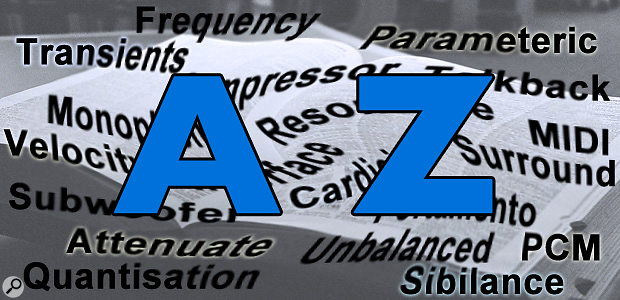You are here
Glossary
When a frequency or pitch is transposed up by one octave, its frequency is doubled.
A sound generation technique used in many electronic organs and string machines involves twelve oscillators which generate each note in the highest octave of the instrument. The signal (usually a square wave) from each oscillator is then passed to circuitry which acts as a mathematical divider, producing an output which sounds an octave lower, and this process is repeated for as many octaves the instrument is required to play. In this way all notes are available all the time, and the tuning between octaves is completely locked and stable.
A process carried out while a recording is not playing. For example, some computer-based processes have to be carried out off-line as the computer isn't fast enough to carry out the process in real time. Also used to refer to a remote-controlled machine which is not currently active.
Directional microphones are inherently more sensitive to sound from one direction, and the direction of greatest sensitivity is referred to as the principle axis. Sound sources placed on this axis are said to be ‘on-axis’, while sound sources elsewhere are said to be ‘off-axis’
The unit of electrical resistance.
A microphone or loudspeaker polar pattern with equal sensitivity in all directions (often abbreviated to Omni). Also the MIDI mode where data on all channels is recognised.
A break in an electrical circuit that prevents current from flowing. (see Short Circuit)
A tape machine where the tape is wound on spools rather than housed within a cassette.
A high-resolution networked communication protocol for computers, synthesizers and other audio devices.
The basic software that enables a computer to load and run other programs.
The concept of configuring a computer in such as way as to maximise its performance for certain tasks. In the context of a machine being used as a DAW, optimisation might involve disabling sub-programs that access the internet regularly or intermittently, such as email hosts, automatic program update checkers and so on. It might also include the structure of the hard drive, or the separation of program data to a system drive and audio data to a separate drive to minimise access times and maximise data throughputs.
– A device where some electrical parameter changes in response to a variation in light intensity. For example, variable photo-resistors are sometimes used as gain control elements in compressors where the side-chain signal modulates the light intensity.
A specific form of near-coincident microphone array devised by the Office de Radiodiffusion Télévision Française (ORTF) at Radio France, the French national broadcaster. The technique employs a pair of small-diaphragm cardioid microphones mounted with a mutual angle of 110 degrees and spaced apart by 17cm. The theoretical stereo recording angle is 96 degrees.
An abbreviation for 'oscillator' or 'Open Sound Control'.
A circuit designed to generate a periodic electrical waveform.
see Polarity.
The effective internal impedance (resistance which many change with signal frequency) of an electronic device. In modern audio equipment the output impedance is normally very low. Microphones are normally specified with an output impedance of 150 or 200 ohms, although some vintage designs might be as low as 30 Ohms.
The nominal output voltage generated by a microphone for a known reference acoustic sound pressure level. Output sensitivity is normally specified for a sound pressure level of one Pascal (94dB SPL), and may range from about 0.5mV/Pa for a ribbon microphone, to 1.5mV/Pa for a moving coil, and up to 20 or 30mV/Pa for a capacitor microphone.
The intentional use of overloaded analogue circuitry as a musical effect.
Recording new material to separate tracks while auditioning and playing in synchronism with previously recorded material.
To exceed the maximum acceptable signal amplitude of an electronic or electrical circuit. Overloading a device results in a noticeable increase in distortion but this may be deemed musically beneficial and desirable, or completely unacceptable and inappropriate, depending on context and intent. Overloading an analogue device typically results in the waveform peaks becoming flattened (so tending towards a square wave) and a consequent rapid increase in odd-order harmonic distortion where the distortion products appear at higher frequencies than the source signal fundamentals, but remain musically related to them. In contrast, overloading a digital system inherently contravenes the Nyquest Theorum, since he generated harmonic distortion products generally extend far above half the sampling frequency, and so become aliased and actually appear at lower frequencies than the source fundamentals with a non-musical relationship. This is why digital overloads sound so obvous and unpleasant in comparison to analogue overloads.
a component of a complex sound which has a higher frequency than the fundamental frequency, but which is not necessarily related by a simple integer multiple (cf. harmonics)

